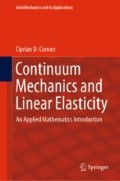Abstract
A simple example of anti-plane problem has already been discussed in some detail earlier in Chap. 5 (Example 5.2, as well as Exercises 5.11 and 5.12). We now consider a more elaborate anti-plane situation related to the torsional deformation of long and slender cylinders. Our treatment relies on the displacement formulation of the problem (based on the Navier–Lamé system) together with a semi-inverse approach. It is possible to give a more direct solution to the torsion problem by circumventing the need for ‘guessing’ the form of the displacement field. Such a treatment was first reported in the literature by the Italian engineer R. Baldacci (1957), who used the Beltrami–Michell equations as the starting point in his analysis; an expanded version of his original solution can be found in Baldacci (Scienza delle Costruzioni, 1983) [1] (pp. 200–238). L. Solomon (Élasticité Lineaire, 1968) [2] has also pursued a similar direct route, albeit his work was partly based on the use of complex variables (see pp. 140–183 of his book).
Access this chapter
Tax calculation will be finalised at checkout
Purchases are for personal use only
Notes
- 1.
Recall that points in \(\mathbb {E}^3\) are identified with their position vectors—see Sect. 1.4.
- 2.
It is tacitly assumed in this equation that an origin has been chosen in \(\varSigma \), relative to which we measure \(\varvec{X}_{\perp }\); this choice and the effect it has on the various quantities of interest (stresses, displacements, and so on) will be taken up at length in Sect. 7.6.
- 3.
Note that \(\alpha =\mathrm {d}\theta /\mathrm {d}X_3\), so it represents the rate of change of \(\theta \) along the \(X_3\)-axis, i.e. along the cylinder axis.
- 4.
As this equation is linear in \(\varvec{a}\) and the outward unit normal on \(\varSigma ^{-}\) is parallel to (\(-\varvec{a}\)), the other equation in (7.5d) does not give any new information.
- 5.
- 6.
The same parametrisation of the boundary curve will apply to all transverse cross sections (\(\varSigma \)) of the cylinder.
- 7.
If F(z) is analytic then \( \pm \mathrm{i}F(z)\) share the same property.
- 8.
The summation convention is tacitly employed here (i ranges from 1 to N).
- 9.
The fact that there exists a maximum of \(\varphi \) in \(\varSigma \cup \partial \varSigma \) is a direct consequence of the boundedness assumption on \(\varSigma \) and the continuity of \(\varphi \).
Bibliography
Baldacci R (1983) Scienza delle Costruzioni, vol 1. Unione Tipografico-Editrice Torinese, Torino (in Italian)
Solomon L (1968) Élasticité Lineaire. Mason, Paris (in French)
Filonenko-Borodich M (1963) Theory of elasticity. Mir Publishers, Moscow
Leipholz H (1974) Theory of elasticity. Noordhoff International Publishing, Leyden
Little RW (1973) Elasticity. Prentice-Hall Inc, Englewood Cliffs, New Jersey
Malvern LE (1969) Introduction to the mechanics of a continuum medium. Prentice-Hall Inc, Englewood Cliffs, New Jersey
Nadeau G (1964) Introduction to elasticity. Holt, Rinehart and Winston Inc, New York
Saada AS (1993) Elasticity: theory and applications. Krieger Publishing Company, Malabar, Florida
Slaughter WS (2002) The linearized theory of elasticity. Birkhäuser, Boston
Sokolnikoff IV (1956) Mathematical theory of elasticity. McGraw-Hill Book Company Inc, New York
Timoshenko SP, Goodier JN (1970) Theory of elasticity, International edn. McGraw-Hill Book Company, Auckland
Author information
Authors and Affiliations
Corresponding author
Rights and permissions
Copyright information
© 2020 Springer Nature B.V.
About this chapter
Cite this chapter
Coman, C.D. (2020). Torsion. In: Continuum Mechanics and Linear Elasticity. Solid Mechanics and Its Applications, vol 238. Springer, Dordrecht. https://doi.org/10.1007/978-94-024-1771-5_7
Download citation
DOI: https://doi.org/10.1007/978-94-024-1771-5_7
Published:
Publisher Name: Springer, Dordrecht
Print ISBN: 978-94-024-1769-2
Online ISBN: 978-94-024-1771-5
eBook Packages: EngineeringEngineering (R0)

